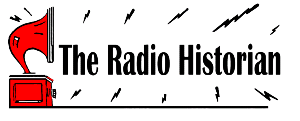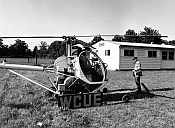|
www.theradiohistorian.org
Copyright 2018 -
John F. Schneider & Associates, LLC
[Return
to Home Page]
(Click
on photos to enlarge)
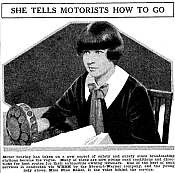
WBBM
in Chicago broadcast traffic condition reports from the studio in 1926.
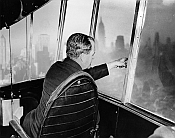
What
was possibly radio’s first airborne traffic report took place
on August 10, 1935.
Deputy
Police Commissioner Harold I. Fowkerer
observed New York City’s traffic routes from a Goodyear blimp,
reporting on the
congested routes for WINS. Here,
he
points to a traffic jam at 59th St. and the Queensboro Bridge. (Author’s collection)
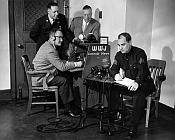
February, 1957:
Detroit
Police Sergeant Leo Crittenden
broadcast expressway reports directly from police headquarters over
WWJ. The broadcasts were made
at ten-minute
intervals from 6:00 to 9:00 AM and 4:30-6:00 PM weekdays. Inspector
Lloyd Preadell
and Traffic Director James A. Hoye watch as WWJ engineer Harry Lewis
and Sgt. Crittenden
report.
(Author’s collection)
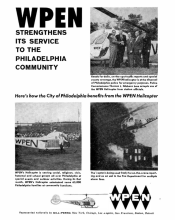
1958: WPEN in Philadelphia
promotes its new helicopter.
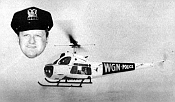
Chicago police
officer Leonard Baldy broadcast daily
reports and conducted programs about
traffic safety. Baldy was killed in a crash on May 2, 1960, after a
rotor blade disintegrated during a traffic flight. He
was the first of several radio traffic reporters to die in aircraft
crashes.
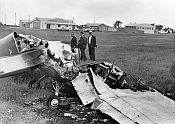
Pilot David "Windy" Knutson and a passenger
were injured when their WLOL traffic plane crashed on takeoff near
Minneapolis, 1964.
November,
1966: WCUE in
Akron started its "Trafficopter" service on an experimental basis
with a leased helicopter. The reports proved so popular that the
station soon acquired a helicopter of its
own and expanded the service to regular five-day tours of 7:15 to 8:30
AM and
4:30 to 5:30 PM. Here, program director Joel
Rose, center, tells the pilot, inside, which route to take for a
rush-hour traffic report. WCUE
traffic reporter Charles Watkins is at right. (Author’s
collection)
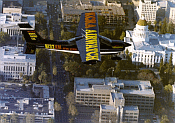
The KCRA “Airwatch” plane soars
over the California capitol
building in Sacramento in this 1970s photograph, provided by the former
KCRA radio
Airwatch pilot, Dan Shively.
|
|
It
was a marriage made in heaven. As
America’s love affair with the automobile packed
the highways faster than the country could build them, motorists needed
to know
how to navigate the congestion.
Meanwhile,
radio stations, facing their own growing congestion on the dial, sought
new
ways to lure listeners away from the competition.
And so it wasn’t long after the first radios
were installed in automobiles that the radio traffic report was born.
One
of
the first stations to report on traffic conditions
was WINS in New York City. On August 10, 1935, Police
Deputy Commander
Harold Fowler flew over the city’s main traffic arteries in a Goodyear
blimp, informing
motorists about the least congested routes.
Curiously, these first broadcasts were made only on
the weekends. Two
years later, KNX in Los Angeles began
regular reporting of weekend traffic conditions as announcer Tom Hanlon
observed
the traffic flow from a United Airlines plane, describing the
congestion on the
city’s popular beach and mountain escape routes.
In
1948
in Chicago, the Cook County Sheriff’s Department broadcast
its “Birds Eye” service during the Memorial Day weekend over WMAQ. A deputy and a pilot flew
helicopter routes
over the city from mid-afternoon to dark.
They didn’t broadcast their descriptions live, but
instead would land
periodically to phone in their reports to the station.
The experiment was carried out with the
approval of the City Council in an attempt to minimize holiday traffic
congestion in the city. WMAQ
repeated the
special broadcasts over the July 4 and Labor Day weekends that year.
But
radio reporting of traffic congestion still wasn’t universally
appreciated in those early years.
In
1951, the local police chief of Huntington, West Virginia, complained
that WSAZ’s
on-air coverage of a traffic accident had contributed to excessive
congestion,
“with the net result that we had to dispatch badly-needed traffic men
to
attempt to handle the abnormal traffic.” The
station refuted the claim and affirmed its
belief that the broadcasts provided an important public service to the
community.
Despite
these early beginnings, the concept of daily
commute-hour traffic reporting didn’t seem to take hold until the
mid-1950’s. At
first, it was the local police departments
dispensing the information, phoned in from police headquarters. In February, 1957,
WWJ in Detroit initiated
its “Expressway Reports” with an officer calling in every ten minutes
from a
WWJ desk installed at the police station.
About the same time, WAVE in Louisville began airing
morning and
afternoon reports from a newsperson stationed at police headquarters. Other stations in
metropolitan areas also
began covering traffic with their mobile units cruising the freeways.
Gordon
McLendon’s KLIF in Dallas was probably the first
station to broadcast live traffic reports from its own aircraft. In 1956, he hired a
helicopter to broadcast
hourly traffic reports. Then
WOR in New
York debuted its “Flying Studio”, with traffic reports aired afternoons
beginning March, 1957. The
fixed-wing WOR
plane also served to cover breaking news events.
Others following suit in 1958 included WLW in
Cincinnati, KABC in Los Angeles, KGO in San Francisco, KXYZ in Houston,
WJBK in
Detroit, and WPEN in Philadelphia.
Although
a few stations chose to cover traffic conditions from
fixed-wing aircraft, most elected to use helicopters in spite of the
greater expense,
because of their superior maneuverability and ability to hover. But this also added an
element of risk, as
helicopters were not proven as safe as airplanes.
In 1958, WGN in Chicago introduced its daily
“Trafficopter” reports with great fanfare.
Chicago police officer Leonard Baldy broadcast daily
reports over the
city, and also conducted regular programs about traffic safety. But on May 2, 1960, WGN
listeners were horrified
to learn that the popular officer had been killed in a crash after a
rotor
blade disintegrated during a traffic flight. Then
in 1966, another radio traffic pioneer,
Captain Max Schumacher, was killed in a midair collision while working
for KMPC
in Los Angeles.
As
traffic reports became an important feature of the
commute hours at major market stations, the number of aircraft in the
sky
increased dramatically. In
2004, there
were reportedly a dozen radio aircraft in the Los Angeles skies, and
some stations,
such as WCBS in New York, even operated two helicopters at once.
More
crashes followed.
On January 10, 1969, WOR fill-in pilot/reporter
Frank McDermott died
when his helicopter fell into an apartment building in Queens. Listeners heard the crash
live during the
middle of a traffic update. Three alarms were needed to contain the
blaze,
which gutted the building’s entire top floor.
Then another WGN "Eye in the Sky“ reporter,
patrolman Irv Hayden,
died along with his pilot on August 10, 1971, when their helicopter
struck a
utility pole. On
June 4, 1986, ''KFI in
the Sky” reporter Bruce Wayne died when his Cessna fixed-wing plane
crashed
shortly after takeoff from Fullerton Municipal Airport.
And then on January 11, 1993, traffic
reporter Mike Roszman and his pilot were killed in Buffalo after their
WGR
helicopter hit a power line in heavy fog and crashed into the Niagara
River.
With
mounting expenses and risks, the heyday of the air
traffic reporter began to wane in the early 1990s.
WOR ended its traffic flights in 1993 and sold
its helicopter to WCBS. Then
the ownership
consolidation that started with the 1996 Telecommunications Act allowed
station
clusters to share their traffic resources.
This in turn put more of a load upon the pilots. In Los Angeles, Commander
Chuck Street
complained that he was reporting for three stations each day, including
one that
required him to pitch hamburgers, breath mints and sex-enhancing
products while
airborne.
Finally,
emerging technologies laid their disruptive hand on
the traffic reporter’s art, as less glamorous but more cost-efficient
forms of data
collection became available. Now
a
traffic reporter could sit comfortably in his office while watching
highway
video cameras, listen to police radio scanners, and talking to
stringers on the
highway with their cell phones. Take
the
case of “Fearless
Fred”.
After flying
WOR’s helicopter for nearly twenty years, he left the station to become
the
manager of Shadow Traffic in New York City.
His company contracted with several stations to provide traffic
information, mostly gathered on the ground from a variety of
sources.
By the time it was sold to Westwood One and folded
into Metro Traffic in 1998, Shadow Traffic was serving 350 radio and TV
stations
in 15 markets. Metro
Traffic in turn was bought by Clear Channel Communications in 2011 for
$119.2
million, and is now a part of Clear Channel’s Total Traffic Network.
Today,
with the confluence of internet, cellular and GPS
technologies, radio traffic reports have become almost irrelevant. Phone-based services like
Google Maps and
Waze automatically aggregate information from their users’ phones,
combine it
with data from local highway authorities, and then share the
information back
to their subscribers in a localized map-based format.
Motorists no longer have to sit through the
commercials
to catch “Traffic on the 8’s”, in the hopes of catching a nugget of
useful
detail about their own routes. These
apps have become so popular that Waze now claims to have 90 million
users
worldwide. Then
there is Sirius/XM,
which provides continuous traffic information to its subscribers in 23
major
cities via its dedicated traffic channels.
Although
some large stations remain firmly committed to the
service, radio traffic reports are starting to go the way of the dodo
bird
around the country. Some
music stations now
even consider them a tune-out risk.
It
was a wake-up call for many in 2015 when WAMU in Washington, DC,
announced the
end of its legacy morning traffic reports, which Jerry Evans had been
broadcasting from his home in Florida.
In its statement, WAMU said:
“In
a world now filled with smart phone map services, GPS devices in cars,
and
traffic apps, there is better, more up to date information available to
our
listeners than we could provide.”
The
Greek philosopher Heraclitus once proclaimed that “the
only constant in life is change”, and this has certainly been true of
the radio
industry. In its
almost hundred years of
existence, continuously-evolving technologies have brought many
disruptive changes. The
true survivors among us deftly adapt to the
changes without clinging to past traditions.
Nonetheless, as we adopt each new technology, we
often trade glamor for
efficiency. Such is
undoubtedly the case
with the “radio cowboys of the skies”, and as they fly off into the
sunset we realize
we may never see their like again.
BIBLIOGRAPHY:
- Television and Radio News, by Bob Siller: WOR's Flying Studio
- New York Times:
- Oct. 20, 1996: "Fred Feldman, Helicopter Reporter, Dies at 63"
- Oct. 24, 1986: "Traffic Reporters, Shaken by Crash, Ask if it's Worth it"
- 3/13/2004: "Skybound Los Angeles Traffic Reporter Sees Job as a Dying Art"
- 7/3/1997: "Most Radio News of Roads Comes From 2 Services"
- Los Angeles Tiimes:
- 6/5/1986: " Airborne Traffic Reporter Bruce Wayne Dies in Crash"
- 11/15/2009:
"They reported traffic on the fly : Some stations still announce jams
from the sky, but the job is no longer as colorful."
- 8/30/66: "The Final Flight of "Captain Max" Schumacher"
- Washington Post:
- 3/2/1983: The Risky Beat From the High Sky
- 11/13/2015: "WAMU drops longtime traffic reporter Jerry Edwards, announces end to morning rush hour reports"
- Chicago
Tribune 1/26/1993: In The Wake Of A Crash, Airborne Traffic
Reporters Say They Have Little Reason To Fear Flying
- Akron Plain Dealer, 11/15/1966: "Copter Scoops Traffic News, Wins Sloan Award for WCUE"
- Portsmouth Times, Portsmouth Ohio, 7/1/1948: "Helicopter Crews Direct Holiday Traffic in Chicago"
- St. Petersburg Times, 3/14/1948: "Helicopter Cop"
- Minneapolis Star, 6/8/1964: WLOL, "Plane Demolished"
- "Broadcasting" Magazine:
- 9/10/51: WSAZ: Police Claim Hit; WSAZ Defends News Report
- 3/19/1956: News: The Ace Up Radio's Sleeve
- 3/18/1957: WOR: Spots in the Air
- 4/22/1957: WAVE: Simulation Stimulates a Pulse
- 12/30/1957: KABC, KGO Hire New DJ's, Expand to 24 hour operation
- 2/29/1958: WLW Copter to Speed Traffic
- 3/31/1958: KABC Copter Relays Rush Hour Traffic Data.
- 5/12/1958: KGO Covers Commuters in Copter
- 6/2/1958: Helicopter Reports for WJBK
- 7/21/1958: KXYZ Reports Traffic From Air
- 7/21/1958: Mishap Delays Copter Report
- Life Magazine, 8/4/67: "Fearless Fred Feldman: Somebody Up There Likes You Drivers" by Paul O'Neil
- "Radio Digest" Magazine 2-6-1926: "She Tells Motorist How to Go"
- www.strategyanalytics.com 11/30/2015: "The Death of Radio Traffic Reports Foretold - Prematurely", by Roger Lanctot
- Jacobs Media Strategies 11/17/15: "The Beginning Of The End For Radio Traffic Reports?" by Fred Jacobs
This article
appeared in "Radio World" Magazine on December 20, 2017.
www.theradiohistorian.org
John F. Schneider & Associates, LLC
Copyright, 2018
|





